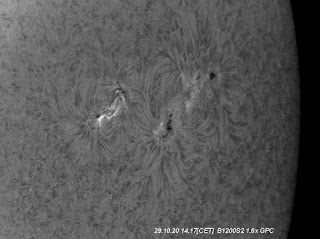*
Thursday 22nd A windy day with cloud spoilt another potentially sunny day.
I decided to update my imaging laptop's internal M.2 SSD hard drive with a larger and faster M.2 NVMe. I chose a 1TB Samsung EVO970 in the hope of avoiding dangling T5 SSDs in the observatory on the end of short cables. The laptop's USB 3 ports are all full and I have a four port USB3 hub to boot for the wireless mouse and keyboard receivers.
Mistake number one was discovering that there is no other hard drive present except the existing internal 256GB M.2 SSD. Somehow it never crossed my mind. I tried to use Samsung's Migration software to clone the data onto an external 1TB T5. That was mistake number two. I had to clear a lot of old videos off both drives to make more than enough room for the transfer.
Well over an hour later I was happy that I had enough room and did the file transfer. Mistake number three was swapping the laptop's SSDs. The EVO970 was briefly recognized in BIOS but now I couldn't escape. With or without the T5 attached to the laptop it couldn't find the OS. So it refused to Update Bios changes and allow me to Escape.
So I swapped the SSD back to the original 256GB. Now it booted normally and I was back in business. The problem is now I can't clone the OS and files onto the EVO970 with only one internal M-2 slot. That was mistake number four.
Mistake number five was ordering the cheapest M-2 external housing online. I was going to move the OS onto the EVO970 that way. Being a pessimistic cynic I checked the manufacturer's website and found it wouldn't suit the EVO970 contacts. SATA only. It couldn't cope with the Type NVMe slot.
By that time it was too late to cancel my order so I had to order another, more expensive case. Mistake No 6? They should both be here tomorrow but I won't open the cheap one so it can be returned without problems. Mistake No7 would be catching the virus when I hand back the unwanted item at the post office.
Two whole days completely wasted without getting the EVO970 recognized by Windows or Samsung Magician. It seems I am not alone. The Internet is full of unhappy EVO970 buyers appealing to computer forums and YouTube posters for advice.
I bought an external case to suit the EVO970 and it was still not recognized. Fitting the original M.2 SSD into the case from the laptop proved that all the extra kit and cables were working fine. I kept my antistatic, earthing, wrist strap on at all times.
I connected the EVO970 to my W10 PC via USB3 and it was still not recognized. Though there was a bleep on connection and later removal.
Back to the laptop with a USB-C connection to the Delock 42600. I managed to find it in Samsung Magician and tried to Initialize. That eventually occurred. So I tried the Samsung Data Migration software. It took a very long time to start and then froze on 33%. I gave it ages to complete but finally had to hit the Stop button. It hasn't been recognized since. Windows tells me it stopped something happening because of a mismatch in its address. Presumably to protect my laptop computer.
This leaves me in a quandary. Do I return the EVO970 and forget the whole idea of an upgrade? Or return it and ask for a replacement on the assumption that the first is simply not working properly?
My online experience in researching EVE970 recognition problems suggests that W10 doesn't like the EVO970. There were fruitless forum discussions, between far more experienced computer nerds, than I could ever pretend to be. The few supposedly useful suggestions demanded I get past recognition and initialisation again. Which doesn't seem to be happening any time soon.
Further online research suggests that Samsung Magician can only recognise an M.2 SSD which is plugged directly into the mother board M slot. Not via USB. So how do I get W10 onto the EVO970 if it can't boot the computer without Windows already on it? The laptop has only one M.2 NVMe slot.
Should I continue struggling and perhaps kill my laptop? I would help if I could use the EVO970 as external storage. Leaving the W10 booting internal drive idea until the dust settles. I can't even get that far! I'm looking at well over £150 expenditure so far,. With only frustration and more than two, full days of wasted time to show for it.
What about an internal SSD HD mounted in the internal HD caddy? I wonder if that would work? The caddy was empty and there is a socket on the mother board for a SATA hard drive. I need to do some more homework.
I did due research and discovered serious problems with ASUS laptop computers and Samsung SSDs compatibility. Some Windows updates were updating the BIOS and stopping the previously working SAMSUNG SSDs from booting.
It really doesn't have to be this difficult! Do these near-monopolies ever do their homework? Do they ever read their own support forums? ASUS obviously doesn't. Not judging by the stream of complaints about a total lack of customer support.
I asked the dealer when I bought the laptop about adding a bigger SSD and was told they couldn't do it. If I did it myself, then I'd immediately void the guarantee. The machine was supplied with only 256GB of SSD. No other drive. I have been fighting a losing battle with video storage space ever since.
*

















































